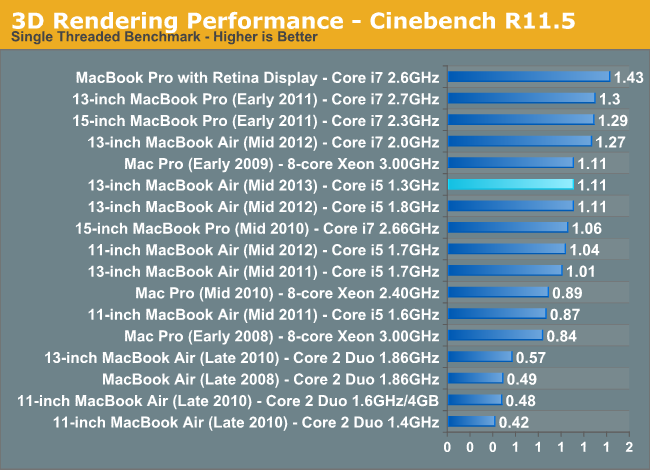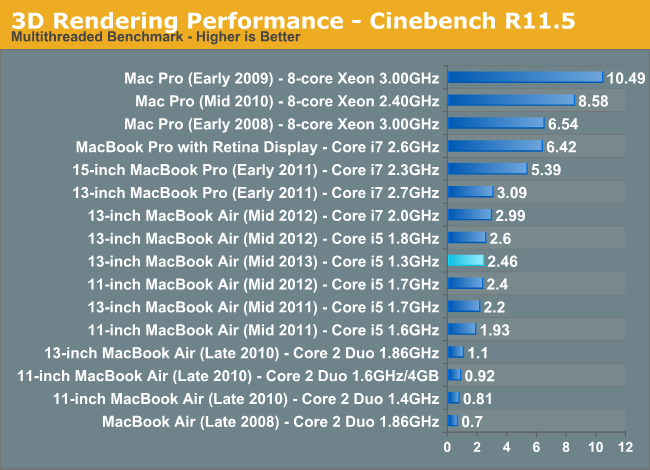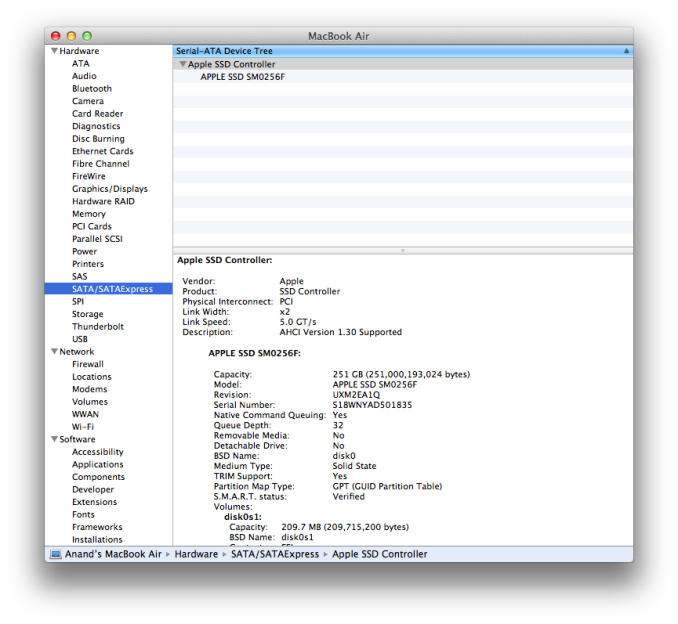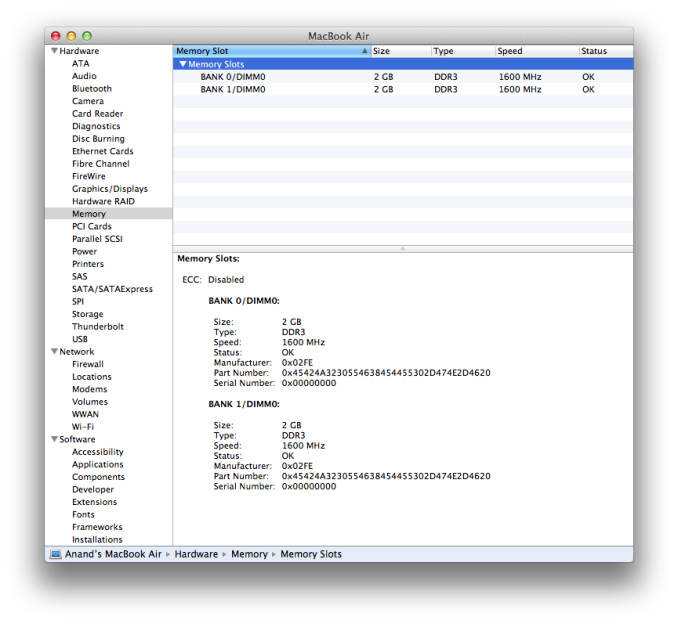2013 MacBook Air: PCIe SSD and Haswell ULT Inside
by Anand Lal Shimpi on June 10, 2013 10:01 PM EST- Posted in
- Mac
- Storage
- SSDs
- Apple
- MacBook Air

This morning Apple updated its MacBook Air to Intel's Haswell ULT silicon. The chassis itself didn't get any updates, nor did the displays. Both the 11 and 13 inch models retain their non-Retina 1366 x 768 and 1440 x 900 displays. There's a slight increase in battery capacity. The 11-inch model moves to 38Wh (8.6%) while the 13-inch model goes to 54.4Wh (8.8%). The big changes however are on the CPU, NAND and DRAM fronts.
With the new MacBook Air, Apple moves to a Core i5-4250U. The base clock drops to 1.3GHz across all of the models, but max turbo remains at 2.6GHz. Although the base clock is lower, I wouldn't expect substantially lower performance since the max turbo is unchanged as is the chassis that has to dissipate the thermals. To confirm, I ran a couple of Cinebench tests and generally found performance similar to that of last year's models:


The 1.8GHz i5 in the 13-inch ended up being a bit quicker than the 1.3GHz 4250U this generation in the multithreaded test, but in single threaded performance the two are equal. The impact on the MT test is about 5%, it's there but not substantial. Don't be fooled by base clock, it's the combination of base clock, max turbo and cooling solution that'll determine performance here. As we found in our Haswell ULT review, CPU performance isn't something you can expect to see more of with Haswell vs. Ivy Bridge in these low wattage platforms.
You can get a 1.7GHz Core i7 upgrade with a 3.3GHz max turbo (i7-4650U). Both parts have Intel GT3 graphics clocked at a max of 1GHz on the i5 and 1.1GHz on the i7. Since the max GPU clocks are south of 1.2GHz, this is officially Intel's HD 5000 graphics and not Iris despite using the same silicon. The GPU base clock drops from 350MHz down to 200MHz, which should help reduce idle power consumption.
| 2013 MacBook Air Lineup | ||||||
| 11.6-inch | 11.6-inch (high-end) | 13.3-inch | 13.3-inch (high-end) | |||
| Dimensions |
H: 0.11-0.68" (0.3-1.7cm) W: 11.8" (30cm) D: 7.56" (19.2cm) |
H: 0.11-0.68" (0.3-1.7cm) W: 12.8" (32.5cm) D: 8.94" (22.7cm) |
||||
| Weight | 2.38 lbs (1.08kg) | 2.96 lbs (1.35kg) | ||||
| CPU | 1.3GHz dual-core Core i5 | 1.3GHz dual-core Core i5 | ||||
| GPU | Intel HD 5000 | |||||
| RAM | 4GB LPDDR3-1600 | |||||
| SSD | 128GB PCIe SSD | 256GB PCIe SSD | 128GB PCIe SSD | 256GB PCIe SSD | ||
| Display Resolution | 1366 x 768 | 1440 x 900 | ||||
| Ports | Thunderbolt, 2x USB 3.0, headphone jack | Thunderbolt, 2x USB 3.0, SD card slot, headphone jack | ||||
| Price | $999 | $1199 | $1099 |
$1299 |
||
On the storage front, Apple officially leads the charge with the move to PCIe based SSDs. The upcoming Mac Pro, as well as the new MacBook Airs both use PCIe based SSDs instead of SATA drives. A quick look at OS X's system profiler reveals a PCIe 2.0 x2 interface, capable of 1GB/s in each direction.
The drive in my system uses a Samsung controller, although I've heard that SanDisk will have a PCIe solution for Apple as well. A quick run through Quick Bench reveals peak sequential read/write performance of nearly 800MB/s:
This is a pretty big deal, as it is probably the first step towards PCIe storage in a mainstream consumer device that we've seen. I'm still awaiting official confirmation as to whether or not this is an M.2 based solution or a proprietary connector. Update: It's a custom Apple design, not M.2. Since there's no PCIe routed off of the CPU in Haswell ULT, these 2 lanes come from the on-package PCH.
The other big change is the move from DDR3L to LPDDR3, a new feature supported by Haswell ULT. I need to go back and dig through the Haswell ULT datasheets again, but I believe the total memory interface width remains at 128-bits wide even if you use LPDDR3 - you just get lower power consumption.
Obviously battery life is the biggest improvement here with the new MacBook Air. Thanks to Haswell's platform power optimizations, Apple claims up to 12 hours on a single charge for the 2013 13-inch MacBook Air. Given the improvements I saw in our Haswell ULT review, I don't doubt that we could see some very good numbers out of these notebooks.
I just got my hands on a 13-inch 2013 MBA and I'll be running performance tests (including the first look at Intel's HD 5000 graphics) over the coming days. I'm still traveling until Thursday but I'll do my best to run battery life tests while I'm on the road as well. More soon!













174 Comments
View All Comments
zogus - Wednesday, June 12, 2013 - link
Most of those sub 1080p windows notebooks that people complain about are a) 14" or larger and b) have 16:9 aspect ratio. MBA 13" has a more useful 16:10 aspect ratio, and it is much better than 1366 x 768, the "standard" resolution for low-res notebooks which is heavily disliked by heavy users. 11" is 1366 x 768, but the screen is so small that people tend to be more forgiving on the issue.Bkord123 - Tuesday, June 11, 2013 - link
Hi everyone. I've been waiting for a few years to upgrade to an Air. Is this the time to do it? I was hoping for retina. Two years I held off because I heard Ivy Bridge was going to be a big deal. Then I held out another year for Haswell. But one of the sentences in this article troubles me: "Although the base clock is lower, I wouldn't expect substantially lower performance..." At the risk of sounding ignorant, why would we see ANY lower performance? It's a new computer for God's sake! Help me understand everyone.jeffkibuule - Tuesday, June 11, 2013 - link
The possibility of having slightly lower performance is because Apple focused heavily on battery life. If you want a true performance machine in this size class, get the 13" Retina MacBook Pro.With the path they've chose, I don't see them doing a Retina MacBook Air for another 1-2 years. It's not worth waiting for at this point. Buy the air if you want the battery life, get the Pro if you want Retina and performance. That's how they are going to justify having 2 13" models for some time.
Bkord123 - Tuesday, June 11, 2013 - link
Here's my entire laptop usage: Email, Internet, YouTube, occasional Netflix. Is this new Air right for me?Scannall - Tuesday, June 11, 2013 - link
Yeskyuu - Tuesday, June 11, 2013 - link
That kind of usage can be handled with a tablet that costs about half as much.perpetuity - Tuesday, June 11, 2013 - link
I use my mid-2011 MBA for: email, internet, internet development (code, light database work), graphic design (from web badges to 16x20 print posters) using old Photoshop (screw Adobe for locking me out of an upgrade!) and Pixelmator; netflix, etc...It's the best computer I have ever owned, period.
Bkord123 - Tuesday, June 11, 2013 - link
I have a general question about the 802.11ac spec. Will that make my Internet any faster or will it just make my Time Machine backups faster? I'm limited by my ISP bandwidth, right? I'm trying to figure out if ac is important to me.Kristian Vättö - Tuesday, June 11, 2013 - link
802.11ac will only increase the bandwidth between your device(s) and router. Actual Internet speeds will still be limited by your ISP.fteoath64 - Tuesday, June 11, 2013 - link
@Bkord123: On a rare case if your laptop has 3 or more concrete walls before it reaches your router, you might connect at less than 20Mbps and not know it. So if you have 30Mbps down or more Internet, you might benefit from the better penetrating power of ac and multi-bonding. Check the router tests from some good sites and do your own speed test to be sure. Some 802.11n routers have poor connection speeds after a certain distance, others are stellar in their performance. Apple just had to update their routers since the new AIRs support ac. Prevents customer question : "Err, but you sold me that feature with nothing to connect to ?!".